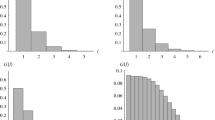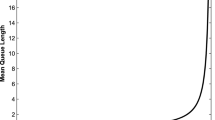Abstract
In this paper we compare the sliding-window (SW) and leaky-bucket (LB) input regulators. These regulators reject, or treat as lower priority, certain arrivals to a queueing system, so as to reduce congestion in the queueing system. Such regulators are currently of interest for access control in emerging high-speed communication networks. The SW admits no more than a specified numberW of arrivals in any interval of specified lengthL. The LB is a counter that increases by one up to a maximum capacityC for each arrival and decreases continuously at a given drain rate to as low as zero; an arrival is admitted if the counter is less than or equal toC−1. To indirectly represent the impact of the regulator on the performance of the queueing system, we focus on the maximum bursts admissible at the peak rate. We show that the SW admits larger bursts than the LB at any given peak rate and admissible average rate. To make the comparison, we use a special construction: We start with a sample path of an arrival process with a given peak rate. We choose a window lengthL for the SW and find the minimum window contentW that is just conforming (so there are no rejections). We then set the LB drain rate equal toW/L, so that the two admissible average rates are identical. Finally, we choose the LB capacityC so that the given arrival process is also just conforming for the LB. With this construction, we show that the SW will admit larger bursts at the peak rate than the LB. We also develop approximations for these maximum burst sizes and their ratio over long time intervals based on extreme-value asymptotics. We use simulations to confirm that these approximations do indeed enable us to predict the burst ratios for typical stochastic arrival processes.
Similar content being viewed by others
References
J. Abate, G.L. Choudhury and W. Whitt, Exponential approximation for tail probabilities in queues, I: waiting times, Oper. Res., to appear.
J. Abate, G.L. Choudhury and W. Whitt, Exponential approximations for tail probabilities in queues, II: sojourn time and workload, Oper. Res., to appear.
A.W. Berger and W. Whitt, Asymptotics for open-loop window flow control, J. Appl. Math. Stoch. Anal. 7 (1994) 337–356.
A.W. Berger and W. Whitt, Maximum values in queueing processes, Prob. Eng. Inf. Sci., to appear.
G.L. Choudhury and W. Whitt, Heavy traffic asymptotic expansions for the asymptotic decay rates in the BMAP/G/1 queue, Stoch. Models 10 (1994) 453–498.
B. Doshi, Deterministic rule based traffic descriptors for Broadband ISDN: worst case behavior and connection admission control,Globecom, Houston, Texas (1993) p. 1759–1764.
P.W. Glynn and W. Whitt, Logarithmic asymptotics for steady-state tail probabilities in a single-server queue, in:Studies in Applied Probability, eds. J. Galambos and J. Gani (Appl. Prob. Trust, Sheffield, UK, 1994) pp. 131–156.
D.P. Heyman, A. Tabatabai and T.V. Lakshman, Statistical analysis and simulation study of video teleconference traffic in ATM networks, IEEE Trans. Circuits and Syst. for Video Tech. 2 (1992) 49–59.
D.L. Iglehart, Extreme values in the GI/G/1 queue, Ann. Math. Statist. 43 (1972) 627–635.
W. Kraemer and M. Langenbach-Belz, Approximate formulae for the delay in the queueing system GI/G/1,8th Int. Teletraffic Congress, Melbourne (1976) pp. 235/1-8.
M.R. Leadbetter, G. Lindgren and H. Rootzén,Extremes and Related Properties of Random Sequences and Processes (Springer, New York, 1983).
D. Lee, Tight performance bounds for. /D/l queues with leaky-bucket-regulated arrivals, Working Paper, MIT (1993).
A.R. Reibman and A.W. Berger, Traffic descriptors for VBR video teleconferencing over ATM networks, IEEE/ACM Trans. Networking 3 (1995) to appear.
J.W. Roberts,Performance Evaluation and Design of Multiservice Networks, COST 224, Final Report (Commission of the European Communities, Luxembourg, 1992).
W. Whitt, Tail probabilities with statistical multiplexing and effective bandwidths for multi-class queues, Telecom. Syst. 2 (1993) 71–107.
Author information
Authors and Affiliations
Rights and permissions
About this article
Cite this article
Berger, A.W., Whitt, W. A comparison of the sliding window and the leaky bucket. Queueing Syst 20, 117–138 (1995). https://doi.org/10.1007/BF01158434
Received:
Revised:
Issue Date:
DOI: https://doi.org/10.1007/BF01158434




